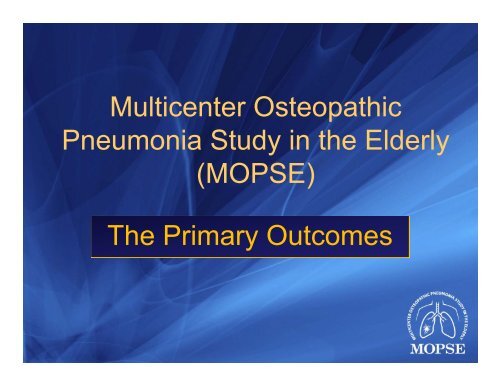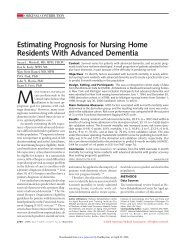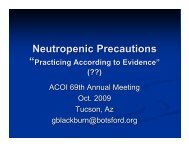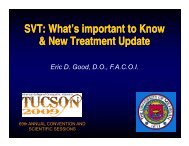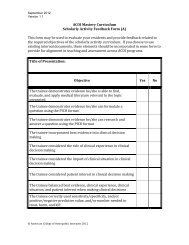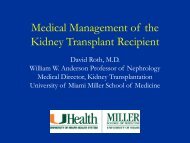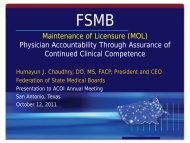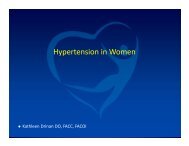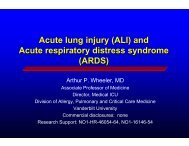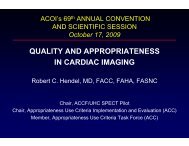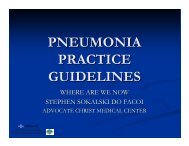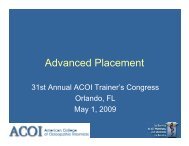Multicenter Osteopathic Pneumonia Study in the Elderly (MOPSE ...
Multicenter Osteopathic Pneumonia Study in the Elderly (MOPSE ...
Multicenter Osteopathic Pneumonia Study in the Elderly (MOPSE ...
You also want an ePaper? Increase the reach of your titles
YUMPU automatically turns print PDFs into web optimized ePapers that Google loves.
<strong>Multicenter</strong> <strong>Osteopathic</strong><strong>Pneumonia</strong> <strong>Study</strong> <strong>in</strong> <strong>the</strong> <strong>Elderly</strong>(<strong>MOPSE</strong>)The Primary Outcomes
BACKGROUND
<strong>MOPSE</strong>(<strong>Multicenter</strong> <strong>Osteopathic</strong> <strong>Pneumonia</strong> <strong>Study</strong> <strong>in</strong> <strong>the</strong> <strong>Elderly</strong>)• A registered study at www.cl<strong>in</strong>icaltrials.gov• Conducted between March 2004 and April 2007• Protocol Paper: www.jaoa.edu– Noll DN, Degenhardt BF, Fossum C, and Hensel K. Cl<strong>in</strong>ical andResearch Protocol for <strong>Osteopathic</strong> Manipulative Treatment of <strong>Elderly</strong>Patients with <strong>Pneumonia</strong> JAOA September 2008; 108: 508-516• Ma<strong>in</strong> Outcomes Paper: www.om-pc.com– Noll DR, Degenhardt BF, Morley FM, Blais FX, Hortos FA, Hensel K,Johnson CJ, Pasta DJ, and Stoll ST. Efficacy of osteopathicmanipulation as an adjunctive treatment for hospitalized patients withpneumonia: a randomized d controlled trial. <strong>Osteopathic</strong> thi Medic<strong>in</strong>e i andPrimary Care 2010, 4:2
Funded by a Consortium of<strong>Osteopathic</strong> Foundations• Brentwood Foundation (Ohio)• Colorado Spr<strong>in</strong>gs <strong>Osteopathic</strong> Foundation (Colorado)• Foundation for <strong>Osteopathic</strong> Health Services (Maryland)• Muskegon General <strong>Osteopathic</strong> Foundation (Michigan)• Northwest Oklahoma <strong>Osteopathic</strong> Foundation (Oklahoma)• <strong>Osteopathic</strong> Founders Foundation (Oklahoma)• <strong>Osteopathic</strong> Institute of <strong>the</strong> South (Georgia)• <strong>Osteopathic</strong> Heritage Foundation (Ohio)• Quad City <strong>Osteopathic</strong> Foundation (Iowa)
<strong>Multicenter</strong> study structure<strong>Osteopathic</strong>Foundations<strong>Osteopathic</strong>ResearchCenter <strong>in</strong> FortWorth, TexasOhio –DoctorsHospitalAT Still ResearchInstitute <strong>in</strong>Kirksville,MissouriNew Jersey– KennedyStratfordMichigan –MountClemensMissouri –NERMCTexas –OMCT,Plaza &John PeterSmith
<strong>Study</strong> Methods
Primary Hypo<strong>the</strong>sis• <strong>Osteopathic</strong> Manipulative Treatmentwill:– Reduce length of stay (LOS)– Reduce time to cl<strong>in</strong>ical stability– Improve <strong>the</strong> symptomatic and functionalrecovery e score
Length of stay (LOS)• A traditional measure• Taken from <strong>the</strong> time and date <strong>the</strong> order waswritten for;– Admission– Discharge• Or <strong>the</strong> closest approximation found <strong>in</strong> <strong>the</strong> chart• At midnight, a new day starts
<strong>MOPSE</strong> Key Aspects (Slide I)1. Randomized Controlled Cl<strong>in</strong>ical Trial• Efficacy study, not a mechanistic study2. Seamless Design• Not to <strong>in</strong>terfere with usual care3. Bl<strong>in</strong>ded <strong>Study</strong>• For <strong>the</strong> decision makers4. Three arm study design• OMT group• Light touch “sham” group• Conventional care only group
<strong>MOPSE</strong> Key Aspects (Slide II)5. OMT is an adjunctive treatment modality• Does not replace conventional care6. Balances uniformity with <strong>in</strong>dividualization• 15 m<strong>in</strong>utes standard, 5 m<strong>in</strong>utes specific7. Best effect design over pragmatic design• Build upon <strong>the</strong> previous studies8. 24 hour w<strong>in</strong>dow• From admission to first treatment
Inclusion Criteria• Age ≥ 50 years• NEW pulmonary <strong>in</strong>filtrate on x-ray• Two of <strong>the</strong> follow<strong>in</strong>g–New, <strong>in</strong>creased cough–Fever ≥ 38 degrees Centigrade–Pleuritic chest pa<strong>in</strong>–New f<strong>in</strong>d<strong>in</strong>gs on physical exam–Respiratory rate ≥ 25 bpm–Mental status change–WBC ≥ 12,000 cells/mm 3
Eight Standardized Techniques1. Thoracolumbar soft tissue2. Rib rais<strong>in</strong>g3. Dom<strong>in</strong>g of <strong>the</strong> diaphragm myofascial release4. Cervical soft tissue5. Suboccipital i decompression6. Thoracic <strong>in</strong>let myofascial release7. Thoracic lymphatic pump8. Pedal lymphatic pump
<strong>MOPSE</strong> <strong>Study</strong> Design SummarySubjectOMTGroupShamTreatmentGroupUsual CareOnly GroupOMT: Twice a day7 days a week15 m<strong>in</strong>utesdurationSham: Twice-a-day7 days a week15 m<strong>in</strong>utesdurationPrimary Outcomes:1) Length of HospitalStay2) Time to Cl<strong>in</strong>icalStability3) Rate of Symptomaticand FunctionalRecoverySecondary Outcomes:• Duration of IV and oralantibiotic treatment• Treatment Endpo<strong>in</strong>ts:Death, RespiratoryFailure and Discharge• 60-day Re-admission• Success <strong>in</strong> Bl<strong>in</strong>d<strong>in</strong>g
Subject Recruitment(from seven community hospitals)3,426 Screened2,883Not Eligible543 Eligible137Decl<strong>in</strong>ed406 Randomized
Demographics• Antibiotic Selection– 84% agreement with practice guidel<strong>in</strong>es• Demographics– No differences, except• Aspiration risk (LT > CCO) by ITT analysis• Current Alcohol Use (OMT < LT, CCO) by PP analysis• <strong>Pneumonia</strong> Severity Index– no between group differences
Randomization and Numbers406 RandomizedOMT LT CCO135 Assigned 136 Assigned 135 Assigned130 ITT 124 ITT 133 ITT96 PP 95 PP127 PPITT = Intention to treat statistical analysisPP = Per protocol statistical analysis
Mean LOSOMT LT CCOIntention to treat analysisn = 130 n = 124 n = 1334.5 days4.9 days4.5 days(SD 2.7) (SD 2.7 (SD 2.6)p = 0.53Per protocol analysisn = 96 n = 95 n = 1274.0 days4.44 days4.5 daysp =0010.01(SD 2.0)(SD 2.4)(SD 2.6)(OMT
Time to Cl<strong>in</strong>ical StabilityOMT LT CCOIntention to treat analysisn = 121 n = 118 n = 1302.5 days2.5 days2.6 days(SD 1.6) (SD 14) 1.4) (SD 16) 1.6)p = 0.97Per protocol analysisn = 90 n = 90 n = 1242.3 days2.5 days2.6 daysp =0470.47(SD 1.4)(SD 1.5)(SD 1.6)
Symptomatic and FunctionalRecovery Score (no statistical difference)2520Group x Time P=0.24Group P=0.47OMT (n=99)LT (n=102)15 CCO (n=99)105Mean SFRS (SD)0Admission 14 -day 30 -day 60 -dayMeasurement Po<strong>in</strong>t
Treatment End Po<strong>in</strong>t Data:Intent to treat analysisOMT LT CCOn = 124 n = 124 n = 132Death2% 3% 6%RespiratoryFailureDischargedAlive3% 3% 8%95% 94% 86% p = 0.08
Treatment End Po<strong>in</strong>t Data:By per protocol analysisOMT LT CCOn = 96 n = 95 n = 132Death 0% 3% 6%RespiratoryFailureDischargedAlive1% 2% 7%99% 95% 87% p = 0.006
Treatment Endpo<strong>in</strong>tIntention-to-TreatAnalysisPer-ProtocolAnalysis100%95% 94%86%100%99% 95%87%80%P=0.0880%P=0.00660%60%40%40%20%0%6% 8%2% 3% 3% 3%20%0%6% 7%3%0% 1% 2%DeathRespiratoryFailureDischargedAliveDeathRespiratoryFailureDischargedAliveOMT (n=124) LT (n=124) CCO (n=132)OMT (n=96) LT (n=95) CCO (n=127)
60-Day Readmission RateOMT LT CCOBy <strong>in</strong>tention to treat analysisn =93 n=96 n=9617 % 20 % 21 % p = 0.64OMT LT CCOBy per protocol analysisN = 80 N = 79 N = 9211 % 20 % 21 % p = 0.16
Bl<strong>in</strong>d<strong>in</strong>g: Percent CorrectlyIdentify<strong>in</strong>g <strong>the</strong>ir GroupIntention to treat analysisOMT LT CCO53 % 44 % 49 %Per protocol analysisproduced similar numbers
Conclusions andDiscussion
Conclusions•By ITT analysis– outcomes not improved• By PP analysis– OMT decreased LOS, duration IV antibiotics,and Mortality• Relative to <strong>the</strong> CCO group• LT groups– outcomes tended to fall between <strong>the</strong> OMT andCCO outcomes
Chang<strong>in</strong>g Mean Length of Stay for<strong>Pneumonia</strong> <strong>in</strong> <strong>the</strong> <strong>Elderly</strong>l
Po<strong>in</strong>ts for Discussion• Does <strong>the</strong> shortened hospital LOS make OMTobsolete?– Where might OMT f<strong>in</strong>d a <strong>the</strong>rapeutic role?• How significant are <strong>the</strong> positive outcomes?– ITT analysis verses PP analysis• Is LT more like OMT or CCO?– How should <strong>the</strong> three group outcomes be<strong>in</strong>terpreted?
Stay tuned for <strong>the</strong> panel discussion<strong>MOPSE</strong> Research Team


